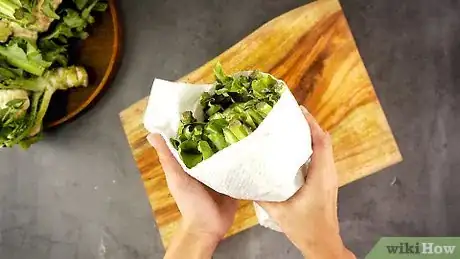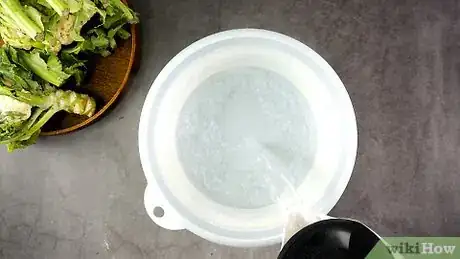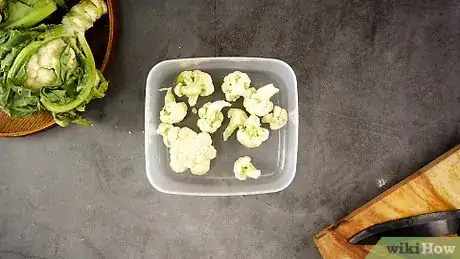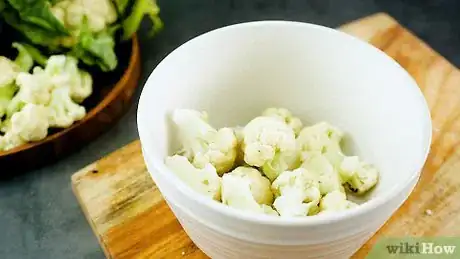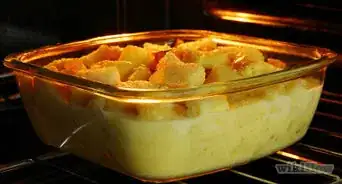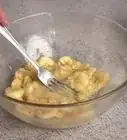This article was co-authored by wikiHow staff writer, Janice Tieperman. Janice is a professional and creative writer who has worked at wikiHow since 2019. With both a B.A. and M.A. in English from East Stroudsburg University, she has a passion for writing a wide variety of content for anyone and everyone. In her free time, you can find her working on a new crochet pattern, listening to true crime podcasts, or tackling a new creative writing project.
The wikiHow Video Team also followed the article's instructions and verified that they work.
This article has been viewed 31,483 times.
Learn more...
If you have a lot of cauliflower on hand, you might not be using all of it at once. Before your produce goes bad, take proper precautions when you store it in the refrigerator. If you’re aiming to keep your cauliflower fresh for a long period of time, try storing it freezer-safe bags. With a little extra preparation, you can enjoy fresh-tasting cauliflower on a short-term and long-term basis!
Steps
Storing in the Fridge
-
1Wrap fresh pieces of cauliflower with a damp paper towel. Soak a clean rag or paper towel in cool water and wring it out. Once your towel is no longer dripping wet, place it on the surface of your produce. Try wrapping the towel around the entire cauliflower, as this will keep it moist and fresh.[1]
- Make sure that rag or paper towel is only damp.
- If you don’t wrap your cauliflower up, it can dry out in storage.
-
2Place the wrapped produce in a perforated plastic bag. Open a special produce bag or other perforated bag that’s large enough to hold your cauliflower. Fit the produce comfortably into the bag, and press out any excess air. Check that the top of the bag is securely sealed before moving it to the refrigerator.[2]
- Since you’re using a perforated bag, it’s not a big deal if the produce bag isn’t fully sealed.
- If you don’t have a perforated bag on hand, use a pair of scissors to cut small holes into a regular storage bag.
Advertisement -
3Arrange the cauliflower in the crisper drawer of your refrigerator. Pull out the bottom crisper drawer of your refrigerator and check that there’s enough space for your produce.[3] Don’t place any other fruits and vegetables near the cauliflower, as this can affect the overall freshness of your produce.[4]
- Don’t overstuff your crisper drawer with food, as your cauliflower could end up getting squashed.
-
4Cook or eat the produce within 4-7 days. Take a mental note of when you place the cauliflower in the refrigerator. Try to cook with or eat the vegetable in the next few days, or else the produce might lose its freshness. If you leave the cauliflower in the refrigerator longer than 1 week, it might not taste as good.[5]
- Brown spots are a normal occurrence on fresh cauliflower. It doesn’t mean that the produce is rotten—it just means that your plant is low in boron.[6]
Freezing the Produce
-
1Pour 1 gallon (3.8 L) of boiling water into a large bowl or basin. Fill a large container with a large amount of hot water. Aim to use about 1 gallon (3.8 L) of water, or enough to completely submerge your produce. If you’re only preserving a small amount of fresh cauliflower, you can use a little less water.[7]
-
2Dissolve 4 tsp (23 g) of salt into the water. Try to use about 4 tsp (23 g) for each 1 gallon (3.8 L) that you’ve poured. After pouring in the salt, stir the water to ensure that the salt is completely dissolved.[8]
- The salt helps keep your cauliflower fresh in the freezer.
-
3Soak the cauliflower into the saltwater solution for 3 minutes. Clean and blanch the produce thoroughly by submerging it in 1 gallon (3.8 L) of salty water. Leave the cauliflower in the water for a few minutes, so the produce can last longer in storage. Once the vegetable has soaked, drain the pot over the sink to get rid of any excess water.[9]
- Use oven mitts or hot pads whenever you try handling containers of hot water.
-
4Cut or split the cauliflower into 1 in (2.5 cm) chunks. Use a large knife to chop your cauliflower into smaller pieces. Aim for the chunks to be equal in size, so they’re easier to package and store. If the vegetable pieces are too big, you might not be able to store them properly.[10]
-
5Arrange the cauliflower pieces in freezer-safe containers. Place the chunks into a plastic container or bag. Before you store the produce, check the labels on the container to ensure that they’re freezer-safe. Try to push out any extra air from the bag or container, so the cauliflower can stay as fresh as possible.[11]
- If you’re using a bag, check that the seal is tight and secure.
- Not all containers are freezer-safe. Check the bottom of your reusable storage boxes to see if they’re safe for long-term use in the freezer.
-
6Label the cauliflower and use it within 1 year. Take a label or piece of masking tape and write down the current date. Secure this label to your container of cauliflower, so you can keep track of its freshness. Ideally, try to eat or cook with your produce between 8 and 12 months so it doesn’t taste dry and freezer-burned.[12]
- While your cauliflower will still be safe to eat after that time, it won’t taste fresh.
- Try to keep your container of cauliflower in a place where you won’t forget about.
-
7Add your frozen cauliflower directly to different dishes. Avoid defrosting the vegetable pieces on your countertop, as this can make them taste less fresh. Instead, try adding the frozen chunks to your recipes. Keep the extra water content in mind when adding frozen cauliflower as an ingredient, as it might make your recipes more watery.[13]
- This works best when adding cauliflower to stews and soups.
Things You Need
Storing in the Fridge
- Paper towel or rag
- Water
- Perforated bag
Freezing the Produce
- Large bowl or basin
- 1 gallon (3.8 L) of boiling water
- 4 tsp (23 g) of salt
- Knife
- Freezer-safe bag or container
References
- ↑ https://harvesttotable.com/harvest-store-cauliflower/
- ↑ https://harvesttotable.com/harvest-store-cauliflower/
- ↑ https://www.oregonlive.com/cooking/2014/05/9_tips_for_buying_storing_and.html
- ↑ https://www.heart.org/en/healthy-living/healthy-eating/add-color/keep-fruits--vegetables-fresher-longer
- ↑ https://www.oregonlive.com/cooking/2014/05/9_tips_for_buying_storing_and.html
- ↑ https://www.foodandwine.com/fwx/food/6-secrets-you-should-know-about-cauliflower
- ↑ https://harvesttotable.com/harvest-store-cauliflower/
- ↑ https://harvesttotable.com/harvest-store-cauliflower/
- ↑ https://www.canr.msu.edu/uploads/resources/pdfs/hni20_cauliflower.pdf
- ↑ https://www.canr.msu.edu/uploads/resources/pdfs/hni20_cauliflower.pdf
- ↑ https://www.canr.msu.edu/uploads/resources/pdfs/hni20_cauliflower.pdf
- ↑ https://www.canr.msu.edu/uploads/resources/pdfs/hni20_cauliflower.pdf
- ↑ https://spoonuniversity.com/how-to/defrosting-frozen-vegetables-like-a-pro-tips-and-tricks-for
